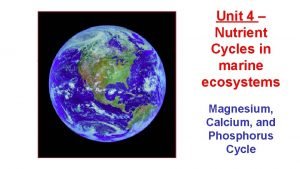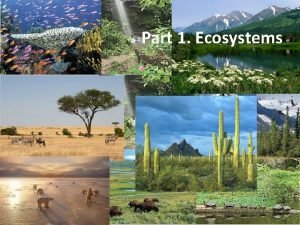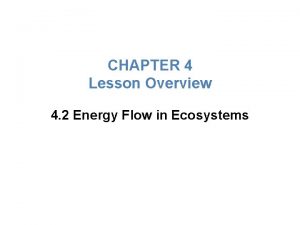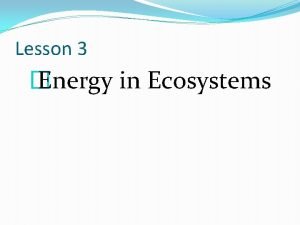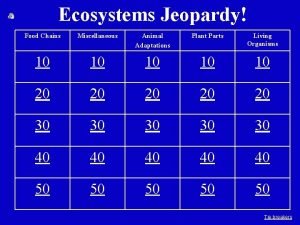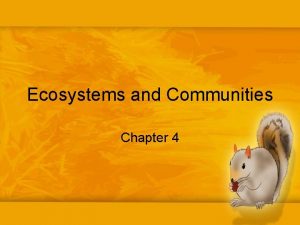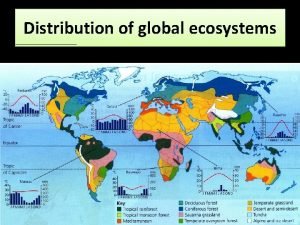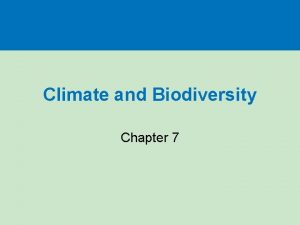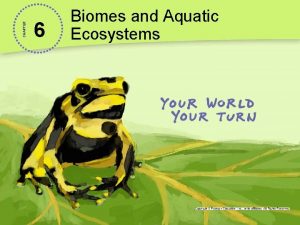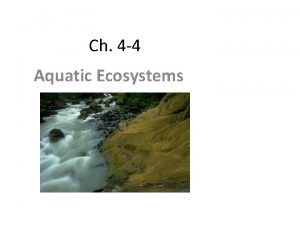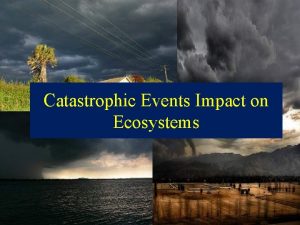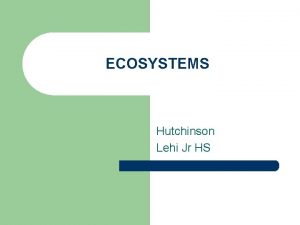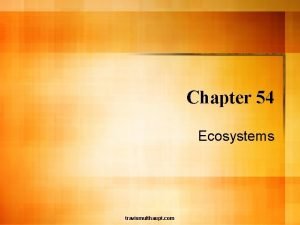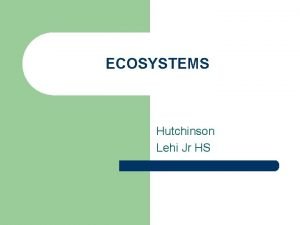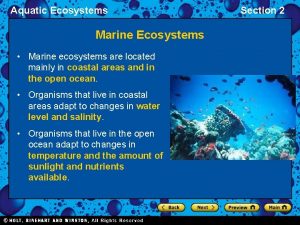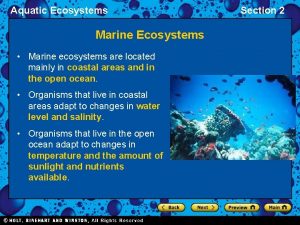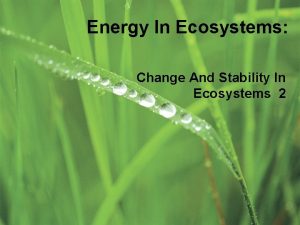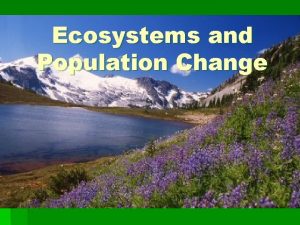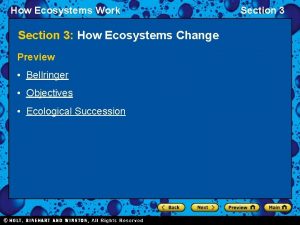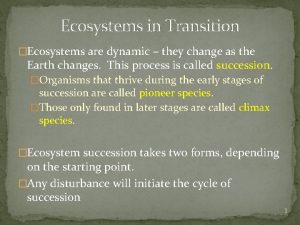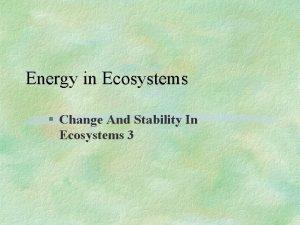What evidence do we have that ecosystems change




















































- Slides: 52


What evidence do we have that ecosystems change?

Have you ever noticed a fast CHANGE in an ecosystem?

Have you ever noticed an ecosystem change?



HAVE YOU EVER CHANGED AN ECOSYSTEM?

HAVE YOU EVER CHANGED AN ECOSYSTEM?

WHAT HAPPENS WHEN WE LEAVE THESECHANGED ECOSYSTEMS ALONE? ?






WHAT IS SUCCESSION? Key Terms for Succession Pioneer Species Primary Succession Secondary Succession Climax Community Succession Video - Explanation

WHAT IS SUCCESSION? Succession: the series of ecological changes that every community undergoes over long periods of time.

Pioneer Species: The first organisms to return to an ecosystem after a dramatic change. They often help to make the environment better for other organisms to return. Ex: Lichens and lupins

CLIMAX COMMUNITY Climax Community: The final stage of succession. This occurs after many years and the ecosystem has reached a new balanced state. There is a wide variety of animals, and larger plants/trees, and trees of different sizes/ages.

MAIN RIVER FOREST, NEWFOUNDLAND

TYPES OF SUCCESSION 1. 2. Two main types of succession: Primary succession Secondary Succession

PRIMARY SUCCESSION Occurs following a change in the environment that has left only bare rock. This means that there is no soil around for plants to quickly move back in.

PRIMARY SUCCESSION

PRIMARY SUCCESSION Primary Succession is a very slow process that can take thousands of years and occurs in the following general sequence:

STAGES OR STEPS TO SUCCESSION Stage 1 Stage 2 Stage 3 Stage 4 Stage 5 Stage 6 24 Lichens More Soil Small Plants Animals Larger Plants Climax Community

STAGE #1: . . . HERE COMES THE LICHENS Lichens start to grow on the rock. These are called pioneer species. 25

STAGE #2: . . HERE COMES MORE SOIL The lichens break down the rock and start to form soil. 26

STAGE #3: . . HERE COMES THE SMALL PLANTS Small, soil. 27 hardy plants begin to grow in the

STAGE #4: . . HERE COMES THE ANIMALS Animals begin to return to the environment and feed on the small plants 28

STAGE #5: . . . HERE COMES THE LARGER PLANTS � Stage 5: Larger plants grow as amount of soil increases from dying plants/animals. 29

STAGE #6. . . CLIMAX COMMUNITY IS FORMING Climax community is formed. Lots of mature trees and high biodiversity. 30

CLIMAX COMMUNITY. . . FINAL STAGE OF SUCCESSION The climax community is the final stage of ecological succession. This stage has the greatest diversity of organisms and very complex food chains and food webs. 31


SECONDARY SUCCESSION Occurs following a change that has left soil on the ground. This makes it much easier for plants and other organisms to return to the area.

SECONDARY SUCCESSION Secondary succession follows the same general pattern as Primary succession, but it happens much more rapidly because there is already soil. (Skip directly to stage#3!)

SECONDARY SUCCESSION

CLIMAX COMMUNITY. . . FINAL STAGE OF SUCCESSION Succession will occur whenever there are favorable circumstances. Over a long period of time (1000’s of years) an area can change from bare rock to a forest if the abiotic and biotic factors are favorable. This change would take place in a series of steps or stages. 36

MT. ST. HELEN’S VOLCANIC EXPLOSION A massive volcanic explosion in the united states gave Ecologists an excellent opportunity to study succession of a forest ecosystem.






STAGES OR STEPS TO SUCCESSION Stage 1 Stage 2 Stage 3 Stage 4 Stage 5 Stage 6 43 Lichens More Soil Small Plants Animals Larger Plants Climax Community

STAGE #1: . . . HERE COMES THE LICHENS Lichens start to grow on the rock. These are called pioneer species. 44

STAGE #2: . . HERE COMES MORE SOIL The lichens break down the rock and start to form soil. 45

STAGE #3: . . HERE COMES THE SMALL PLANTS Small, soil. 46 hardy plants begin to grow in the

STAGE #4: . . HERE COMES THE ANIMALS Animals begin to return to the environment and feed on the small plants 47

STAGE #5: . . . HERE COMES THE LARGER PLANTS � Stage 5: Larger plants grow as amount of soil increases from dying plants/animals. 48

STAGE #6. . . CLIMAX COMMUNITY IS FORMING Climax community is formed. Lots of mature trees and high biodiversity. 49

CLIMAX COMMUNITY. . . FINAL STAGE OF SUCCESSION The climax community is the final stage of ecological succession. This stage has the greatest diversity of organisms and very complex food chains and food webs. 50


WHAT CONTRIBUTES TO SUCCESSION? Climate is a big factor!! Climate is a very important environmental condition that affects succession and includes: Temperature Precipitation Availability of sunlight **Abiotic Factors!!**
 Fiber evidence can have probative value as class evidence.
Fiber evidence can have probative value as class evidence. Phân độ lown
Phân độ lown Block nhĩ thất độ 2 type 1
Block nhĩ thất độ 2 type 1 Thể thơ truyền thống
Thể thơ truyền thống Thơ thất ngôn tứ tuyệt đường luật
Thơ thất ngôn tứ tuyệt đường luật Chiến lược kinh doanh quốc tế của walmart
Chiến lược kinh doanh quốc tế của walmart Tìm độ lớn thật của tam giác abc
Tìm độ lớn thật của tam giác abc Con hãy đưa tay khi thấy người vấp ngã
Con hãy đưa tay khi thấy người vấp ngã Tôn thất thuyết là ai
Tôn thất thuyết là ai Gây tê cơ vuông thắt lưng
Gây tê cơ vuông thắt lưng Sau thất bại ở hồ điển triệt
Sau thất bại ở hồ điển triệt What is succession
What is succession 8 faces 12 edges 6 vertices
8 faces 12 edges 6 vertices Secondary sources
Secondary sources Primary evidence vs secondary evidence
Primary evidence vs secondary evidence Secondary sources
Secondary sources Primary evidence vs secondary evidence
Primary evidence vs secondary evidence Jobs vancouver
Jobs vancouver Class evidence vs individual evidence
Class evidence vs individual evidence How can class evidence narrow a field of suspects
How can class evidence narrow a field of suspects A pair of latex gloves was found at a crime scene
A pair of latex gloves was found at a crime scene The ecological fallacy
The ecological fallacy Chapter 14 section 1 fossil evidence of change answer key
Chapter 14 section 1 fossil evidence of change answer key The history of life section 1 fossil evidence of change
The history of life section 1 fossil evidence of change Example of a chemical change
Example of a chemical change Section 3 water pollution
Section 3 water pollution Biological use of magnesium in marine ecosystems
Biological use of magnesium in marine ecosystems Lesson outline lesson 2 aquatic ecosystems answer key
Lesson outline lesson 2 aquatic ecosystems answer key Aquatic areas
Aquatic areas Ecosystem living and nonliving things
Ecosystem living and nonliving things Ecological succession
Ecological succession Ocean food chain
Ocean food chain Biodiversity
Biodiversity Chapter 4 lesson 2 energy flow in ecosystems
Chapter 4 lesson 2 energy flow in ecosystems Chapter 4 lesson 2 energy flow in ecosystems answer key
Chapter 4 lesson 2 energy flow in ecosystems answer key Interactions within ecosystems grade 7
Interactions within ecosystems grade 7 Section 3 energy in ecosystems
Section 3 energy in ecosystems Ecology title page
Ecology title page Examples of biotic components
Examples of biotic components Ecosystems jeopardy
Ecosystems jeopardy Ecosystems and communities chapter 4 answer key
Ecosystems and communities chapter 4 answer key Distribution of global ecosystems
Distribution of global ecosystems Human impact on terrestrial ecosystems
Human impact on terrestrial ecosystems Aquatic ecosystems webquest
Aquatic ecosystems webquest The chaparral biome is best characterized by _______.
The chaparral biome is best characterized by _______. 3 aquatic biomes
3 aquatic biomes Phosphorus cycle pearson education
Phosphorus cycle pearson education Chapter 42 ecosystems and energy
Chapter 42 ecosystems and energy Chapter 3 lesson 3 biomes and aquatic ecosystems
Chapter 3 lesson 3 biomes and aquatic ecosystems Chapter 16 human impact on ecosystems
Chapter 16 human impact on ecosystems Succession ecosystems
Succession ecosystems 4-4 aquatic ecosystems
4-4 aquatic ecosystems Tornado impact on ecosystem
Tornado impact on ecosystem


























